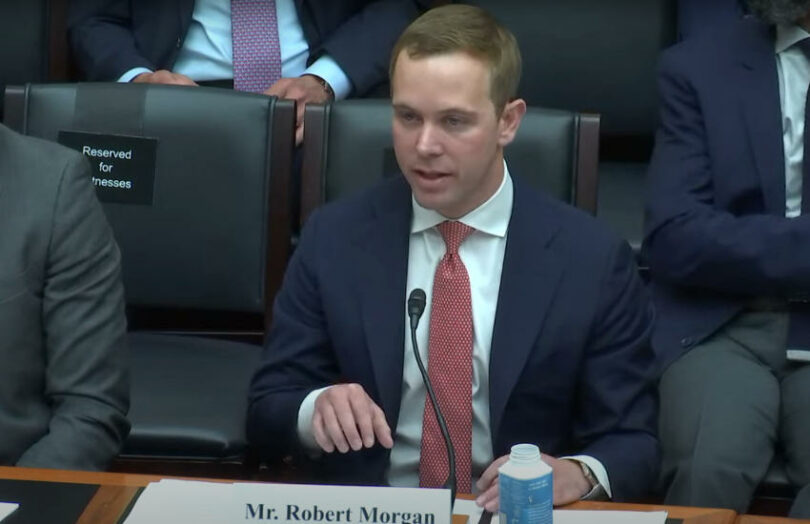During yesterday’s Congressional hearing on stablecoins, one of the witnesses providing testimony was Robert Morgan, the CEO of the USDF Consortium, the network for bank deposit tokens. Currently, the consortium includes eight community banks, community bank group JAM FINTOP and blockchain firm Figure Technologies.
During the hearing, Morgan argued that the future of digital currency is not a two way choice between stablecoins and central bank digital currency (CBDC). Instead, there’s a third way with tokenized deposits. He noted that currently, 73% of US money is comprised of bank deposits and those deposits support credit origination.
We’d observe that it is rarely noted that a mass migration from bank deposits to stablecoins carries similar risks to the wide adoption of a retail CBDC. The potential reduction in available credit could have a major impact on the economy without an alternative source of credit.
When the USDF Consortium was founded in early 2022, the intention was to use the permissionless Provenance blockchain and for deposit tokens to be held directly by bank customers. With regulatory headwinds, that plan has evolved to using a permissioned version of Provenance, and initially, the tokens will only be used by the banks for interbank payments. Customers, especially businesses, still reap the benefits of 24/7 transactions, programmable money and instant settlement.
However, the solution has yet to receive a green light.
A high bar for banking blockchain applications
“The standard for approval for blockchain-based activities is putting banks at a competitive disadvantage,” said Morgan. “Currently, banks must obtain formal approvals from their regulators prior to offering any blockchain product, a standard that does not exist for any other technology. To date no clear set of expectations has been determined for regulatory approval and few approvals have been given.” Hence he asked Congress for regulatory clarity for banks, which is provided in one of the stablecoin Bills.
One of the challenges for community banks is the need for expensive technology investments, which consortia like USDF can help to mitigate by spreading the costs. Both USDF and its competitor TassatPay’s Digital Interbank Network target community banks.
In contrast, JP Morgan has its JPM Coin, which is in production but only used internally between bank customers. However, it is a founding investor in Partior, the blockchain interbank payment network. Our sources told us that the Comptroller of the Currency has recently granted JP Morgan the go ahead to use Partior, but we have not seen the non objection letter.
USDF’s Morgan is concerned that regulators are lumping novel assets such as cryptocurrencies together with the use of the underlying blockchain technology.
“We do not regulate the internet, but instead regulate the numerous industries that leverage the internet to deliver their services,” said Morgan. “Similarly, a one-size-fits-all approach to blockchain that seeks to address the risks that have emerged from novel crypto markets may limit its use in other industries.”
One stablecoin Bill has good news for banks
There are currently two stablecoin Bills, with the latest Republican Bill stating that tokenized deposits are distinct from stablecoins.
Morgan still has concerns that there’s a risk of a broad definition of “payments stablecoin” that could be interpreted as including tokenized deposits. If that were the case, tokenized deposits would have to be fully backed by reserves, despite banks also complying with Basel capital requirements.
The latest draft Republican Bill clarifies that banks can tokenize bank deposits and use blockchain for their ledger or interbank transfers. Additionally, it says banks can provide custodial services for payment stablecoins or their reserves.
There’s another custody clause in the Republican Bill that banks would be delighted with. It states that no Federal agency can require assets held in custody to be included on its balance sheet as a liability. Generally, that is not the accounting treatment for assets in custody, but the SEC introduced an accounting rule in March 2022 that requires this treatment for digital assets.
This potentially has a knock on effect for bank capital rules, requiring additional regulatory capital. That’s despite the Basel Committee that created the bank capital rules saying that assets under custody do not require additional capital by default – even digital assets.
However, if there are some operational risks relating to the custody, some capital might need to be set aside. The Republican stablecoin Bill addresses this by giving the banking regulators the authority to specify these operational risk capital requirements. This effectively removes it from the SEC.
Given the Congressional hearing was about stablecoins, there was little discussion about deposit tokens. But if the Republican Bill wording is adopted, it will be a big step forward for deposit tokens in the United States.






